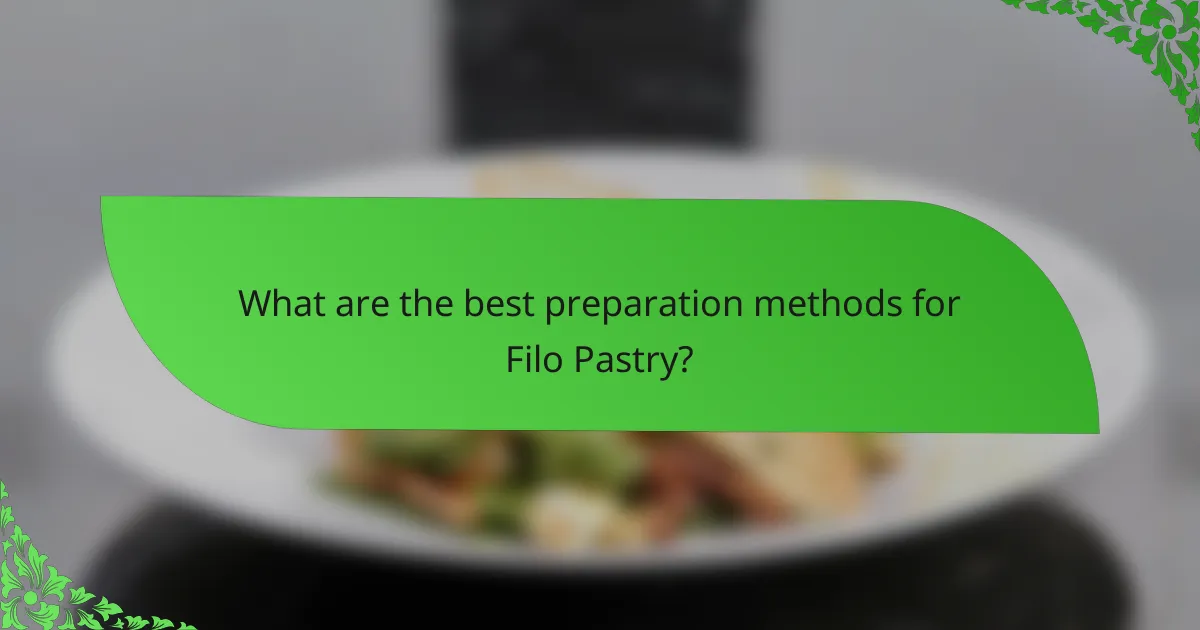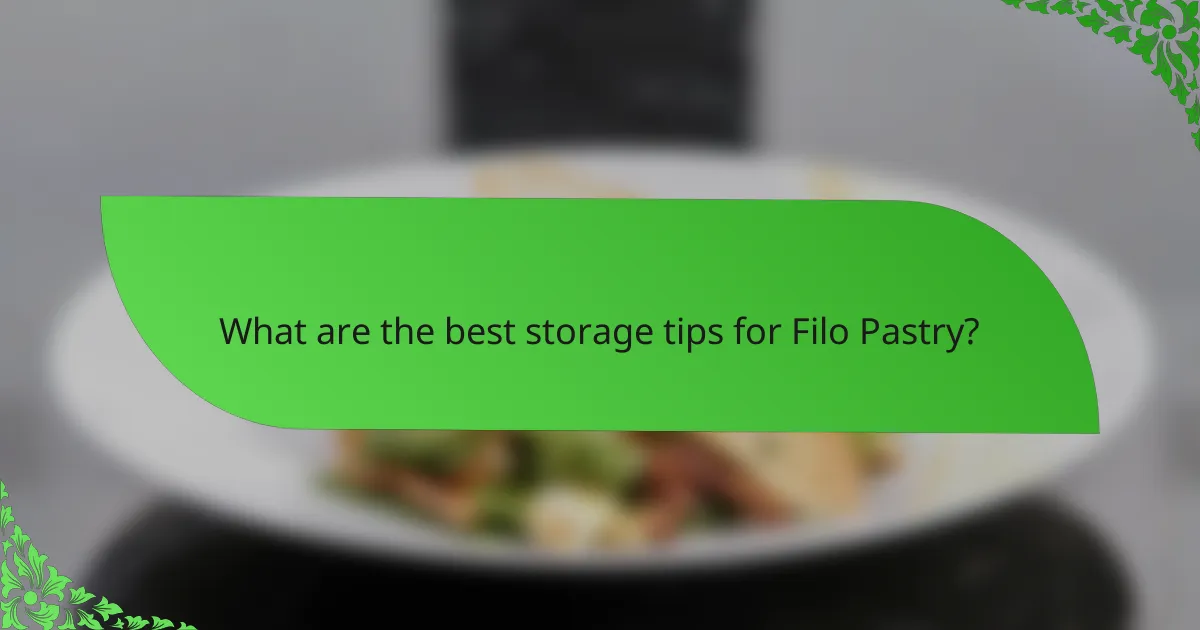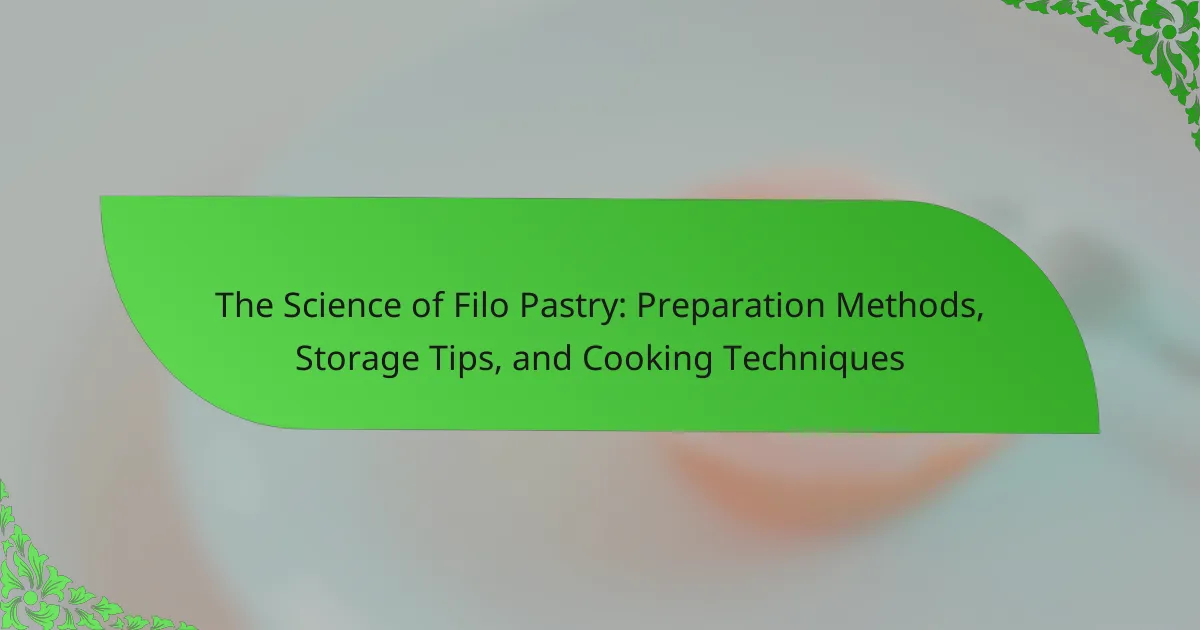Filo pastry is a thin, unleavened dough made from flour, water, and a small amount of oil or vinegar, commonly used in Mediterranean and Middle Eastern cuisines. This article explores the best preparation methods for filo pastry, including thawing, layering, and brushing with fat to achieve optimal texture and flavor. It also provides essential storage tips to maintain freshness and prevent drying out, as well as cooking techniques such as baking and frying that enhance the pastry’s unique flaky characteristics. Understanding these aspects ensures successful use of filo pastry in various dishes like baklava and spanakopita.

What is Filo Pastry?
Filo pastry is a thin, unleavened dough used in various dishes. It is made from flour, water, and a small amount of oil or vinegar. The dough is rolled out into very thin sheets. These sheets can be layered to create a flaky texture when baked. Filo pastry is commonly used in Mediterranean and Middle Eastern cuisines. It is the main ingredient in dishes like baklava and spanakopita. The use of filo pastry dates back to the Ottoman Empire. Its delicate nature requires careful handling to prevent tearing.
How is Filo Pastry made?
Filo pastry is made by mixing flour, water, and a small amount of oil or vinegar. The dough is kneaded until smooth and elastic. It is then divided into small portions. Each portion is rolled out into thin sheets. The sheets are layered with oil or melted butter for added flavor and texture. This process creates the characteristic flaky texture of filo pastry. The thin layers allow for crispness when baked. Filo pastry is commonly used in dishes like baklava and spanakopita.
What ingredients are essential for Filo Pastry?
Filo pastry requires flour, water, and salt as essential ingredients. Flour provides the structure and texture of the pastry. Water hydrates the flour, enabling gluten development. Salt enhances flavor and strengthens the dough. Some recipes may also include oil or vinegar to improve elasticity. The combination of these ingredients creates a thin, flexible dough suitable for layering. Filo pastry is known for its delicate and crispy texture when baked.
What is the process of rolling out Filo Pastry?
The process of rolling out Filo pastry involves several key steps. First, ensure the pastry is thawed if it was frozen. Next, lightly flour the work surface to prevent sticking. Unroll the Filo sheets carefully, keeping them covered with a damp cloth to maintain moisture. Take one sheet and lay it flat on the surface. Brush it lightly with melted butter or oil for added flavor and flexibility. Repeat this layering process with additional sheets, brushing each one. Finally, roll the layered sheets gently into the desired shape or size. This method ensures the Filo remains thin and pliable, essential for achieving the desired texture in baked dishes.
What are the characteristics of Filo Pastry?
Filo pastry is a thin, unleavened dough known for its delicate texture. It consists of multiple layers that create a crispy and flaky result when baked. Filo pastry is typically made from flour, water, and a small amount of oil or vinegar. It is often used in Mediterranean and Middle Eastern dishes, such as baklava and spanakopita. The dough is rolled out to a paper-thin consistency, which requires careful handling to prevent tearing. Filo pastry is low in fat compared to other pastry types, making it a lighter option. It must be kept covered to prevent drying out during preparation. The layering technique contributes to its unique texture and allows for a variety of fillings.
How does the texture of Filo Pastry contribute to its uses?
The texture of Filo Pastry is thin, flaky, and crisp. This unique texture allows for a light and airy quality in dishes. It can easily absorb and hold moisture from fillings. The crispness provides a pleasing contrast to soft or creamy fillings. Filo’s texture enables it to be layered, creating depth in both flavor and structure. Additionally, the lightness of the pastry makes it suitable for both sweet and savory applications. This versatility is evident in popular dishes like baklava and spanakopita. The texture also facilitates quick baking, resulting in a golden, crunchy exterior.
What flavors can be enhanced by using Filo Pastry?
Filo pastry can enhance a variety of flavors, particularly those that are rich and savory. Ingredients like cheese, spinach, and mushrooms pair well with filo, creating a delightful contrast in textures. Sweet flavors also benefit from filo, especially with fillings like nuts, fruits, and honey. The light and crispy nature of filo allows these flavors to shine through without overwhelming them. Additionally, herbs and spices can be accentuated, adding depth to both sweet and savory dishes. The versatility of filo pastry makes it suitable for enhancing Mediterranean and Middle Eastern cuisines. Its ability to create layers adds complexity to the overall flavor profile of the dish.
Why is Filo Pastry popular in various cuisines?
Filo pastry is popular in various cuisines due to its versatility and unique texture. This pastry is known for being extremely thin, allowing for a delicate and flaky result when baked. Its ability to absorb flavors from fillings makes it a preferred choice in both savory and sweet dishes. Filo pastry is commonly used in Mediterranean and Middle Eastern cuisines, featuring in dishes like baklava and spanakopita. The lightness of filo allows for layered preparations, enhancing the overall presentation and taste. Additionally, it is a lower-fat alternative to other pastry types, appealing to health-conscious consumers. Its easy adaptability to different fillings and flavor profiles contributes to its widespread use across diverse culinary traditions.
What traditional dishes feature Filo Pastry?
Traditional dishes that feature Filo Pastry include Baklava, Spanakopita, and Tiropita. Baklava is a sweet dessert made with layers of Filo filled with nuts and honey syrup. Spanakopita is a savory pie filled with spinach and feta cheese, wrapped in Filo. Tiropita is a cheese pie made with Filo, typically filled with a mixture of cheeses and eggs. These dishes are commonly found in Mediterranean and Middle Eastern cuisines. Their use of Filo Pastry contributes to a flaky texture and rich flavor.
How does Filo Pastry compare to other types of pastry?
Filo pastry is distinct from other types of pastry due to its thin, unleavened sheets. Unlike puff pastry, which is layered with butter and creates a flaky texture, filo is crisp and light when baked. Filo pastry is lower in fat compared to shortcrust or puff pastry. This results in a different mouthfeel and calorie content.
Filo is often used in Mediterranean dishes like baklava and spanakopita, emphasizing its versatility. Other pastries, such as puff pastry, require more time and skill to prepare due to the lamination process. Filo’s preparation involves layering sheets, which can be quicker and simpler.
In terms of storage, filo pastry can be frozen for longer periods, while puff and shortcrust pastry have shorter shelf lives. This makes filo a practical choice for various culinary applications.

What are the best preparation methods for Filo Pastry?
The best preparation methods for Filo Pastry include thawing, layering, and brushing with fat. Thawing should be done in the refrigerator overnight. This prevents the pastry from becoming too moist or tearing. Layering involves stacking multiple sheets to create a sturdier base. Typically, three to five sheets are used for optimal texture. Brushing each layer with melted butter or oil enhances flavor and prevents sticking. This technique also aids in achieving a golden, crispy finish when baked. Proper preparation ensures the pastry maintains its delicate texture and crispiness during cooking.
How should Filo Pastry be thawed before use?
Filo pastry should be thawed in the refrigerator overnight before use. This method allows for even thawing and maintains the pastry’s texture. Alternatively, it can be thawed at room temperature for about 30 minutes. It is important to keep the pastry covered with a damp cloth to prevent it from drying out. Once thawed, filo pastry should be used promptly for best results. This ensures the layers remain pliable and easy to work with.
What are the best practices for handling thawed Filo Pastry?
To handle thawed Filo Pastry effectively, keep it covered with a damp cloth to prevent drying. This pastry is delicate and can easily become brittle if exposed to air. Use it promptly after thawing for best results. Working with one sheet at a time helps maintain its moisture and flexibility. If the sheets stick together, gently separate them without tearing. Avoid stacking too many sheets at once to ensure even cooking. Preheat your oven before baking to achieve a crisp texture. These practices help maintain the quality of the Filo Pastry during preparation.
What tools are recommended for working with Filo Pastry?
Recommended tools for working with filo pastry include a rolling pin, pastry brush, and sharp knife. A rolling pin helps to flatten the pastry sheets evenly. A pastry brush is essential for applying butter or oil between layers. A sharp knife is necessary for cutting the pastry into desired shapes. Additionally, a clean work surface is crucial to prevent sticking. A damp cloth can keep the unused sheets moist. These tools facilitate the handling and preparation of filo pastry effectively.
What techniques can enhance the quality of Filo Pastry dishes?
Using techniques such as proper layering, controlled moisture, and correct baking temperature can enhance the quality of Filo Pastry dishes. Proper layering involves using a sufficient amount of melted butter or oil between each layer to achieve flakiness. Controlled moisture is essential; covering unused sheets with a damp cloth prevents them from drying out. Correct baking temperature is critical; preheating the oven to a high temperature, around 375°F (190°C), ensures even cooking and crispiness. Additionally, using fresh Filo Pastry, which has a higher moisture content, contributes to better texture and flavor. These techniques collectively improve the overall quality of Filo Pastry dishes.
How can layering affect the final product of Filo Pastry?
Layering significantly impacts the final product of Filo Pastry. Each layer contributes to the texture and structure of the pastry. Proper layering creates a light and flaky texture. This results from the steam generated between the layers during baking. The more layers used, the more pronounced the flakiness. Conversely, insufficient layering can lead to a dense and chewy product. The quality and thickness of each layer also influence the final outcome. Thinner layers tend to yield a more delicate and crispy result. Overall, the technique of layering is crucial for achieving the desired pastry characteristics.
What role does butter or oil play in preparing Filo Pastry?
Butter or oil serves as a critical ingredient in preparing filo pastry. It provides moisture and fat, which contribute to the texture and flavor of the pastry. When brushed between layers, butter or oil helps to separate the sheets, creating a flaky structure. This layering is essential for achieving the desired crispiness during baking. The fat also aids in browning, enhancing the visual appeal of the final product. Additionally, butter or oil can prevent the sheets from drying out, ensuring they remain pliable for easier handling. The use of fat is a traditional method, with butter often preferred for its rich flavor.

What are the best storage tips for Filo Pastry?
Store Filo pastry in the refrigerator to maintain its freshness. Keep it in its original packaging if unopened. If opened, wrap the pastry tightly in plastic wrap to prevent it from drying out. Place a damp cloth over the wrapped pastry for added moisture. For long-term storage, freeze Filo pastry. Use an airtight container or heavy-duty freezer bag to avoid freezer burn. Thaw frozen pastry in the refrigerator before use. These methods help retain the texture and prevent breakage. Proper storage extends the shelf life of Filo pastry significantly.
How should Filo Pastry be stored after opening?
Filo pastry should be stored in an airtight container after opening. This prevents moisture from making the pastry soggy. Alternatively, wrap the pastry tightly in plastic wrap. Keeping it in the refrigerator can extend its shelf life for a few days. It is important to use the pastry within a week for best results. If freezing, ensure it is well-wrapped to avoid freezer burn. Frozen filo pastry can last up to three months. Always check for any signs of spoilage before use.
What are the signs that Filo Pastry has gone bad?
Filo pastry has gone bad if it shows signs of mold, an off smell, or a dry, brittle texture. Mold appears as green or black spots on the surface. An off smell can indicate spoilage due to bacterial growth. A dry, brittle texture means the pastry has lost moisture and is no longer usable. Additionally, if the pastry has been stored past its expiration date or in improper conditions, it may also be bad. Always inspect the packaging for any tears or openings that could compromise freshness.
Can Filo Pastry be frozen for later use?
Yes, filo pastry can be frozen for later use. Freezing preserves its texture and prevents spoilage. To freeze, wrap the pastry tightly in plastic wrap or aluminum foil. This prevents freezer burn and moisture loss. When ready to use, thaw it in the refrigerator overnight. Properly frozen filo pastry can last up to three months. This method maintains its quality for baking or cooking.
What is the best method for freezing Filo Pastry?
The best method for freezing filo pastry is to wrap it tightly in plastic wrap. This prevents freezer burn and moisture loss. After wrapping, place the filo pastry in an airtight freezer bag or container. Ensure to remove as much air as possible from the bag. Label the package with the date for reference. Filo pastry can be frozen for up to two months without significant loss of quality. When ready to use, thaw it in the refrigerator overnight before unwrapping. This method maintains the pastry’s texture and prevents it from becoming soggy.

What cooking techniques are best suited for Filo Pastry?
Baking and frying are the best cooking techniques for filo pastry. Baking allows the layers to crisp up evenly. It is ideal for making items like baklava and spanakopita. Frying creates a golden, flaky texture quickly. This technique is often used for small pastries or appetizers. Both methods enhance the unique texture of filo pastry. The high-fat content in the butter or oil used contributes to the crispness. Proper temperature control is essential for achieving the desired results.
How can Filo Pastry be baked for optimal results?
Filo pastry can be baked for optimal results by following specific techniques. First, preheat the oven to 375°F (190°C). This temperature ensures even cooking and crispiness. Next, layer the filo sheets with melted butter or oil. This adds flavor and promotes browning. Use a brush to apply the fat evenly across each sheet.
Ensure the layers are not too thick. Thin layers allow for better airflow and crispiness. Additionally, cover unused filo sheets with a damp cloth to prevent them from drying out. Place the assembled pastry on a baking tray lined with parchment paper. This prevents sticking and promotes even baking.
Bake the pastry for 15 to 20 minutes. Check for a golden-brown color to indicate doneness. Rotate the tray halfway through baking for even cooking. Allow the pastry to cool slightly before serving. This helps maintain its structure and crispness.
What temperature and time are ideal for baking Filo Pastry?
The ideal temperature for baking filo pastry is 375°F (190°C). The recommended baking time is typically 15 to 20 minutes. This temperature allows the pastry to become golden brown and crispy. Baking at this heat ensures even cooking throughout the layers. It is essential to monitor the pastry to avoid over-browning. When baked correctly, filo pastry achieves its desired flaky texture.
What frying methods work well with Filo Pastry?
Filo pastry is best suited for shallow frying and deep frying methods. Shallow frying involves cooking the pastry in a small amount of oil, allowing it to crisp up while maintaining its delicate texture. This method is ideal for making items like spanakopita or small pastries. Deep frying fully immerses the pastry in hot oil, creating a crunchy exterior. This technique is commonly used for sweet or savory fillings, resulting in a golden, flaky product. Both methods effectively enhance the flavor and texture of filo pastry dishes.
How does frying affect the texture of Filo Pastry?
Frying creates a crispy and flaky texture in Filo Pastry. The high temperature of the oil causes the moisture in the layers to evaporate quickly. This rapid evaporation leads to the formation of air pockets within the pastry. As a result, the outer layers become golden brown and crunchy. The frying process also enhances the overall flavor of the pastry. The Maillard reaction occurs, adding depth to the taste. Fried Filo Pastry is often used in dishes like baklava and spanakopita, showcasing its appealing texture.
What are some common troubleshooting tips for using Filo Pastry?
To troubleshoot Filo pastry, ensure you keep it covered to prevent drying out. Dry Filo can become brittle and hard to work with. Use a damp cloth or plastic wrap to maintain moisture. If the pastry tears, use a small amount of melted butter to seal the edges. This can help prevent further tearing. Additionally, work quickly when handling Filo to minimize exposure to air. If the layers stick together, gently separate them with a pastry brush or fingers. Properly thaw frozen Filo overnight in the refrigerator for best results. Always follow the manufacturer’s instructions for storage and handling.
How can you prevent Filo Pastry from drying out during preparation?
To prevent filo pastry from drying out during preparation, keep it covered with a damp cloth. This method retains moisture and prevents the layers from becoming brittle. Additionally, work quickly to minimize exposure to air. When handling the pastry, only remove the sheets you need and immediately cover the remaining sheets. Using a spray bottle to lightly mist the pastry with water can also help maintain moisture. These techniques are effective because filo pastry is very thin and dries out quickly when exposed to air. Keeping it moist ensures that it remains pliable for layering and baking.
What should you do if Filo Pastry tears while working with it?
If filo pastry tears while working with it, you can patch it up with another layer. Place a small piece of filo over the tear and brush it with melted butter or oil. This helps to seal the tear and maintain the integrity of the pastry. Additionally, you can use a damp cloth to keep the remaining pastry moist while you work. Filo pastry is delicate, and moisture is key to preventing further tears. If the tear is too large, consider using a new sheet of filo to cover the area. This method is effective as it allows you to salvage the pastry without compromising the final dish.
Filo pastry is a thin, unleavened dough primarily made from flour, water, and oil or vinegar, known for its delicate and flaky texture. This article explores the preparation methods, storage tips, and cooking techniques associated with filo pastry, highlighting its versatility in Mediterranean and Middle Eastern cuisines. Key topics include the essential ingredients, proper handling, layering techniques, and optimal baking and frying methods. Additionally, the article provides troubleshooting tips to ensure successful results when working with this delicate pastry.
